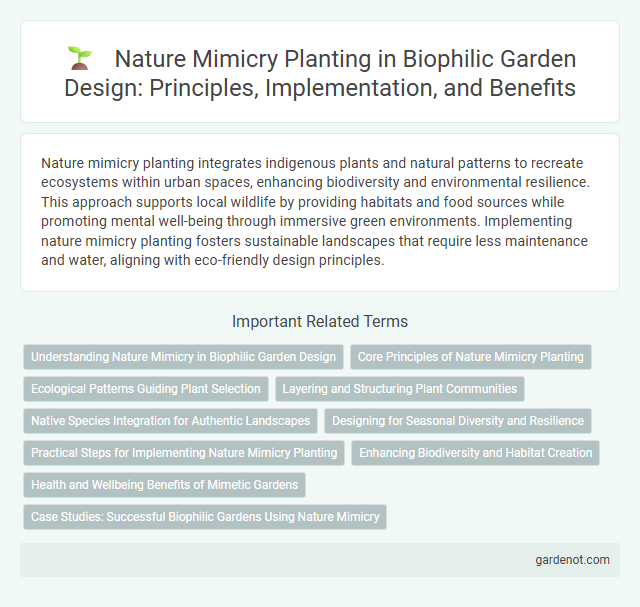Nature mimicry planting integrates indigenous plants and natural patterns to recreate ecosystems within urban spaces, enhancing biodiversity and environmental resilience. This approach supports local wildlife by providing habitats and food sources while promoting mental well-being through immersive green environments. Implementing nature mimicry planting fosters sustainable landscapes that require less maintenance and water, aligning with eco-friendly design principles.
Understanding Nature Mimicry in Biophilic Garden Design
Nature mimicry in biophilic garden design involves replicating natural patterns, structures, and ecosystems to create harmonious outdoor spaces that promote well-being and biodiversity. By closely studying native plant communities, growth habits, and natural cycles, designers curate plant palettes that foster resilient and self-sustaining environments. This approach enhances ecological connectivity, supports local wildlife, and delivers sensory experiences that resonate with human evolutionary preferences for natural landscapes.
Core Principles of Nature Mimicry Planting
Nature mimicry planting emphasizes replicating natural ecosystems by prioritizing native plant species, diverse plant layers, and seasonal dynamics. Core principles include fostering biodiversity through species variety that supports local fauna, promoting soil health with organic matter, and creating self-sustaining plant communities that adapt to changing environmental conditions. These strategies enhance ecosystem resilience, improve air and water quality, and create immersive natural experiences within built environments.
Ecological Patterns Guiding Plant Selection
Nature mimicry planting in biophilic design leverages ecological patterns such as plant community structure, seasonal dynamics, and native species compatibility to create sustainable, resilient landscapes. Emphasizing native flora that thrives in local microclimates promotes biodiversity, soil health, and natural pest control. Strategic plant selection based on ecological succession stages and mutualistic relationships enhances habitat connectivity and supports urban wildlife populations.
Layering and Structuring Plant Communities
Layering and structuring plant communities in biophilic design emulates natural ecosystems by incorporating diverse plant species at varying heights and densities. This technique enhances ecological function, supports biodiversity, and creates immersive green spaces that improve air quality and human well-being. Strategic layering mimics forest stratification, providing habitat complexity and promoting resilience against environmental stressors.
Native Species Integration for Authentic Landscapes
Nature mimicry planting enhances biophilic design by integrating native species that replicate local ecosystems, promoting ecological balance and biodiversity. Utilizing indigenous plants supports authentic landscapes that require less maintenance and water, aligning with sustainable environmental practices. This approach fosters a strong connection between occupants and their natural surroundings, improving wellbeing through genuine habitat representation.
Designing for Seasonal Diversity and Resilience
Nature mimicry planting incorporates native species and varied plant forms to emulate natural ecosystems, enhancing seasonal diversity and ecosystem resilience. By prioritizing adaptive species that thrive across different seasons, designers create dynamic landscapes that support biodiversity and respond to climate fluctuations. This approach fosters sustainable environments that maintain aesthetic appeal and ecological function year-round.
Practical Steps for Implementing Nature Mimicry Planting
Incorporating nature mimicry planting involves selecting native plant species that replicate local ecosystems to enhance biodiversity and ecological balance. Begin by analyzing the site's soil, climate, and existing vegetation to ensure compatibility and resilience of the chosen plants. Implement layering techniques with ground covers, shrubs, and canopy species to create a dynamic, self-sustaining landscape that supports wildlife and promotes natural processes.
Enhancing Biodiversity and Habitat Creation
Nature mimicry planting in biophilic design replicates natural ecosystems by incorporating native plant species that support local wildlife, significantly enhancing biodiversity in urban environments. This approach fosters habitat creation for pollinators, birds, and beneficial insects, promoting ecological balance and resilience. Strategic layering of vegetation types mimics natural trophic structures, optimizing ecosystem services such as air purification, soil stabilization, and microclimate regulation.
Health and Wellbeing Benefits of Mimetic Gardens
Nature mimicry planting in mimetic gardens promotes mental restoration by replicating natural ecosystems, reducing stress and enhancing cognitive function. Exposure to these green spaces improves air quality, lowers blood pressure, and supports immune health through natural phytoncides emitted by diverse plant species. Incorporating native flora and layered vegetation fosters biodiversity, creating therapeutic environments that boost mood and overall wellbeing.
Case Studies: Successful Biophilic Gardens Using Nature Mimicry
Case studies of successful biophilic gardens using nature mimicry demonstrate how replicating local ecosystems enhances biodiversity and promotes ecological resilience. Gardens such as the High Line in New York City and the Gardens by the Bay in Singapore incorporate native plant species and naturalistic arrangements that support pollinators and replicate natural habitat conditions. These projects highlight the effectiveness of biomimicry planting in creating sustainable, restorative urban green spaces.
Nature mimicry planting Infographic

 gardenot.com
gardenot.com